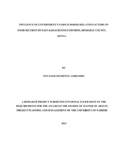| dc.description.abstract | The agricultural sector is a significant element of the economies of many countries and which
contributes to the realization of major development milestones. According to a report by United
Nations’ World Summit on Sustainable Development on Food Security, poverty eradication,
agriculture and food security have moved to the center stage of global development agenda. The
international community, at a World Summit on Food Security held in Johannesburg in 2002,
reaffirmed its commitment to develop national and local programmes for sustainable
development, poverty eradication and food security (UNDP, 2002). Following this Summit,
many countries in Africa revamped their subsidy programmes in which poor farmers were
supplied with agricultural farm inputs at controlled and subsidized prices, and often on heavily
subsidized credit. As the Kenyan Government continues to operationalize the Agricultural Sector
Development Strategy (ASDS)and Vision 2030 there is still need to address the influence of its
subsidy programme on food security. This study therefore examined the influence of farm
subsidies related factors on food security in East Karachonyo Division, Homa-Bay County. The
study was guided by the following objectives; determining how access to information of the
subsidy programme, training of farmers on the use of subsidies, provision of inputs and the
extent to which time of distribution influence the use of the government’s farm subsidies and
their effect on food security. The study targeted all the beneficiary farmers under the
government’s subsidy programme in East Karachuonyo Division, the Sub-County Agricultural
Officer, Divisional Agricultural Officer and four Extension Officers and adopted a descriptive
survey design where qualitative and quantitative data was collected. The target population was
stratified proportionately according to the three main regions in the division where farming
activities take place to provide every region with equal chance in the study. Simple Random
Sampling was then used to pick the final samples from the population strata. Purposive Sampling
was used to sample the Agriculture personneland interview schedules were used to gather
information from the six key informants. Structured questionnaires were used to gather data from
254 respondents, a sufficient sample size from the target population of 752 according to Krejcie
and Morgan table. Piloting of the study was done in Kasipul Division to refine both tools by
testing their strengths and weaknesses and adjustments made accordingly. The collected data was
then analyzed qualitatively and quantitativelyusing of SPSS version 19. The presentation and
interpretations were done using frequency tables, figures and percentages for quantitative data.
Narrative analysis was used to analyze the qualitative data where information was focused by
themes and organized into coherent categories that summarized and brought meaning to the text,
patterns of connections identified and interpreted. The study established that 69% of small holder
farmers were widowed females aged 41 to 50 years. It was evident from the study that small
holder agriculture attracted less educated people (80%) without requisite knowledge and skills
for the highly competitive job market. The former provincial administration structures proved to
be the most effective medium of disseminating information in rural set ups as rated by 76% of
respondents. The major type of subsidized input received by most farmers from the government
was certified seeds (67%)and fertilizers (28%). However, 96% of the respondents felt that these
subsidies were not distributedat the right time. Finally, the study concluded that not any of the
factors when considered on their own ensured food sufficiency. The study recommended an
integrated approach that combines agriculture technology, timely provision of the required
support training and inputs, backed up with a working feedback mechanism to promote effective
management and control of sustainable and competitive agriculture leading to food security and
improvement of livelihoods | en_US |

